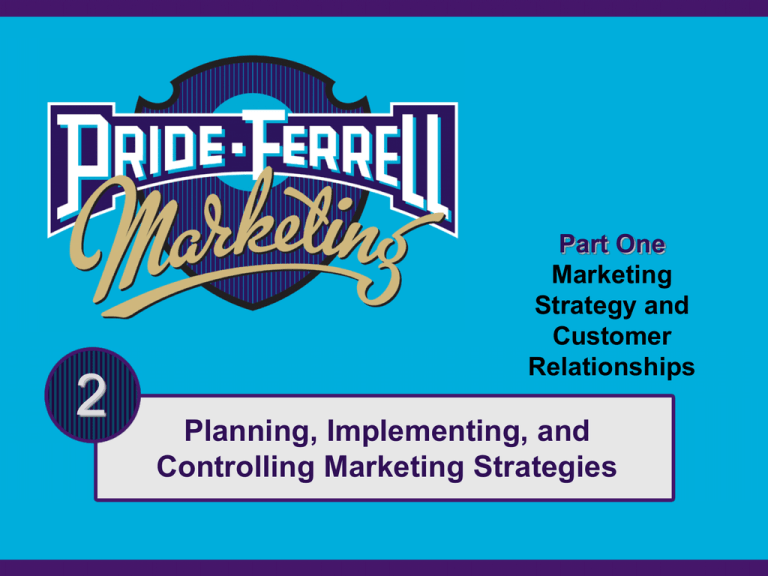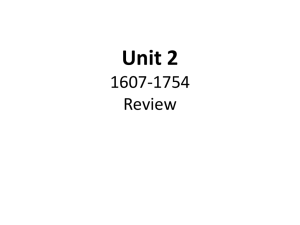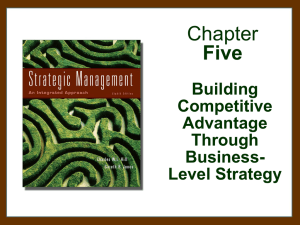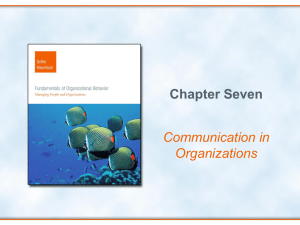
2
Part One
Marketing
Strategy and
Customer
Relationships
Planning, Implementing, and
Controlling Marketing Strategies
Objectives
1. To describe the strategic planning
process
2. To explain how organizational
resources and opportunities affect the
planning process
3. To understand the role of the mission
statement in strategic planning
4. To examine corporate, business-unit,
and marketing strategies
Copyright © Houghton Mifflin Company. All rights reserved.
2 | 2
Objectives (cont’d)
5. To understand the process of creating
the marketing plan
6. To describe the marketing
implementation process and the major
approaches to marketing
implementation
Copyright © Houghton Mifflin Company. All rights reserved.
2 | 3
Chapter Outline
• Understanding the Strategic Planning
Process
• Assessing Organizational Resources and
Opportunities
• Establishing an Organizational Mission and
Goals
• Developing Corporate, Business-Unit, and
Marketing Strategies
• Creating the Marketing Plan
• Implementing Marketing Strategies
Copyright © Houghton Mifflin Company. All rights reserved.
2 | 4
Understanding the Strategic Planning
Process
• Strategic Planning
– The process of establishing an
organizational mission and formulating
goals, corporate strategy, marketing
objectives, marketing strategy, and a
marketing plan
Copyright © Houghton Mifflin Company. All rights reserved.
2 | 5
Components of Strategic Planning
Source: Figure adapted from Marketing Strategy, Second Edition, by O. C. Ferrell, Michael Hartline, and George Lucas, Jr.
Copyright © 2002. Reproduced with permission of South-Western, a division of Thomson Learning.
Copyright © Houghton Mifflin Company. All rights reserved.
FIGURE 2.1
2 | 6
Marketing Strategy and Marketing Plan
• Marketing Strategy
– A plan of action for identifying and
analyzing a target market and developing
a marketing mix to meet the needs of that
market
• Marketing Plan
– A written document that specifies
the activities to be performed to
implement and control an
organization’s marketing activities
Copyright © Houghton Mifflin Company. All rights reserved.
2 | 7
Assessing Organizational Resources and
Opportunities
• Core Competencies
– Things a firm does extremely well
(strengths), which sometimes give it an
advantage over its competition
• Financial and human resources
• Reputation, goodwill, and brand names
Copyright © Houghton Mifflin Company. All rights reserved.
2 | 8
Assessing Organizational Resources and
Opportunities (cont’d)
• Market Opportunity
– A combination of circumstances and timing
that permits an organization to reach a
target market
• Core competencies are matched to
opportunities
• Strategic windows—
temporary periods of optimal
fit between the key requirements
of a market and the particular
capabilities of a firm
Copyright © Houghton Mifflin Company. All rights reserved.
2 | 9
Assessing Organizational Resources and
Opportunities (cont’d)
• Competitive Advantage
– The result of a company’s matching
a core competency (superior skill
or resources) to opportunities
in the marketplace
• Manufacturing skills
• Technical skills
• Marketing skills
Copyright © Houghton Mifflin Company. All rights reserved.
2 | 10
SWOT Analysis
• An assessment of the organization’s
strengths, weaknesses, opportunities, and
threats
– Strengths—competitive advantages or core
competencies
– Weaknesses—limitations on competitive
capability
– Opportunities—favorable conditions in the
environment
– Threats—conditions or barriers to reaching
objectives
Copyright © Houghton Mifflin Company. All rights reserved.
2 | 11
The Four-Cell SWOT Matrix
Source: Reproduced from Nigel F. Piercy, Market-Led Strategic Change. Copyright © 1992, p. 371, with
permission from Elsevier Science.
Copyright © Houghton Mifflin Company. All rights reserved.
FIGURE 2.2
2 | 12
Establishing an Organizational Mission and
Goals
• Mission Statement
– A long-term view, or vision, of what the
organization wants to become
– Mission statement answers two questions:
• Who are our customers?
• What is our core
competency?
Copyright © Houghton Mifflin Company. All rights reserved.
2 | 13
Establishing an Organizational Mission and
Goals (cont’d)
• Marketing Objective
– A statement of what is to be accomplished
through marketing activities to match
strengths to opportunities, or to provide for
the conversion of weaknesses to strengths
• Should be stated in clear, simple terms
• Should be accurately measurable
• Should specify a time frame for
accomplishment
• Should be consistent with business-unit and
corporate strategy
Copyright © Houghton Mifflin Company. All rights reserved.
2 | 14
Levels of Strategic Planning
FIGURE 2.3
Copyright © Houghton Mifflin Company. All rights reserved.
2 | 15
Corporate Strategy
• A strategy that determines the means
for utilizing resources in the various
functional areas to reach the
organization’s goals
–
–
–
–
Determines the scope of the business
Guides its resource deployment
Identifies its competitive advantages
Provides overall coordination of functional
areas
Copyright © Houghton Mifflin Company. All rights reserved.
2 | 16
Corporate Strategy (cont’d)
• Issues Influencing Corporate Strategy
Development
–
–
–
–
–
–
Corporate culture
Competition
Differentiation
Diversification
Interrelationships among business units
Environment concerns and social issues
Copyright © Houghton Mifflin Company. All rights reserved.
2 | 17
Business-Unit Strategy
• Strategic Business Unit (SBU)
– A division, product line, or other profit center
within a parent company
• Market
– A group of individuals and/or organizations that
have needs for products in a product
class and have the ability,
willingness, and authority to
purchase those products
• Market Share
– The percentage of a market that
actually buys a specific product
from a particular company
Copyright © Houghton Mifflin Company. All rights reserved.
2 | 18
Business-Unit Strategy (cont’d)
• Market-Growth/Market-Share Matrix
– A strategic planning tool based on the
philosophy that a product’s market growth
rate and market share are important in
determining marketing strategy
– Factors determining SBU/product’s
position within a matrix
• Product-market growth rate
• Relative market share
Copyright © Houghton Mifflin Company. All rights reserved.
2 | 19
Growth-Share Matrix Developed by the
Boston Consulting Group
Source: “The BCG Portfolio Matrix” from the Product Portfolio Matrix, © 1970, The Boston Consulting
Group. Reproduced by permission.
Copyright © Houghton Mifflin Company. All rights reserved.
FIGURE 2.4
2 | 20
Business-Unit Strategy (cont’d)
• Market-Growth/Market-Share Matrix (cont’d)
– BCG Classification
• Star—high growth market, dominant market share
– requires additional resources for continued growth
• Cash cow—low growth, dominant market share
– generates surplus resources for allocation to other SBUs
• Dog—low/declining market, subordinate market share
– has diminished prospects and represents a drain on the
portfolio
• Question mark—high growth market, low market share
– represents a high-risk/cost opportunity requiring a large
commitment of resources to build market share
Copyright © Houghton Mifflin Company. All rights reserved.
2 | 21
Marketing Strategy
• Target Market Selection
– Defining/understanding the target market by
• focusing on specific profitable customer groups/market
segments.
• recognizing changes occurring in the market.
• Creating the Marketing Mix
• Analyze customer needs, preferences, and behavior
• Have the skills and resources required for product
design, pricing, distribution, and promotion
• Maintain strategic consistency and flexibility in
marketing mix decisions
Copyright © Houghton Mifflin Company. All rights reserved.
2 | 22
Net Sights
• Corporate executives and marketing
managers must stay informed to
develop successful strategies. CEO
Express (www.ceoexpress.com)
provides access to newspapers,
business journals, special-interest
publications, and syndicated news
services as well as a variety of other
resources.
Copyright © Houghton Mifflin Company. All rights reserved.
2 | 23
Creating the Marketing Plan
• Marketing Planning
– The systematic process of assessing
opportunities and resources, determining
objectives, defining strategies, and
establishing guidelines for implementation
and control of the marketing
program
Copyright © Houghton Mifflin Company. All rights reserved.
2 | 24
Creating the Marketing Plan (cont’d)
• Benefits of Planning
– Provides the basis for internal
communication among employees
– Defines the assignment of responsibilities
and tasks and sets the schedules for
implementation
– Presents objectives and specifies resource
allocations
– Helps in monitoring and evaluating the
performance of the marketing strategy
Copyright © Houghton Mifflin Company. All rights reserved.
2 | 25
Copyright © Houghton Mifflin Company. All rights reserved.
2 | 26
Implementing Marketing Strategies
• Marketing Implementation
– The process of putting marketing strategies into
action
• Intended Strategy
– The strategy that the company decides on during
the planning phase
• Realized Strategy
– The strategy that actually takes place
Intended
Strategy
Implementation
Copyright © Houghton Mifflin Company. All rights reserved.
Realized
Strategy
2 | 27
Approaches to Marketing Implementation
• Internal Marketing
– Coordinating internal exchanges between
the firm and its employees to achieve
successful external exchanges between
the firm and its customers
– Helping employees understand and accept
their roles in the marketing strategy
– External customers
• Individuals who patronize a business
– Internal customers
• A company’s employees
Copyright © Houghton Mifflin Company. All rights reserved.
2 | 28
Total Quality Management
• Total Quality Management (TQM)
– A philosophy that uniform commitment to quality
in all areas of the organization will promote a
culture that meets customers’ perceptions of
quality
• Benchmarking
– Comparing the quality of the firm’s goods,
services, or processes with that of the bestperforming competitors
• Empowerment
– Giving customer-contact employees authority and
responsibility to make marketing decisions on
their own
Copyright © Houghton Mifflin Company. All rights reserved.
2 | 29
Components of Total Quality Management
Total Quality
Management
Continuous
Quality
Improvement
Copyright © Houghton Mifflin Company. All rights reserved.
Empowered
Employees
2 | 30
Organizing Marketing Activities
• The Role of Marketing in an Organization
Understanding customer
needs and desires
Organizational goals for
customer value and firm
profitability
Marketing Concept
Close coordination of organizational units
Copyright © Houghton Mifflin Company. All rights reserved.
2 | 31
Organizing Marketing Activities (cont’d)
• Centralized Organization
– A structure in which top management
delegates little authority to levels below it
• Decentralized Organization
– A structure in which decision-making
authority is delegated as far down the
chain of command as possible
Copyright © Houghton Mifflin Company. All rights reserved.
2 | 32
Organizing the Marketing Unit
Alternatives for Organizing
the Marketing Unit
Centralized
or
Decentralized
Marketing
Functions
Copyright © Houghton Mifflin Company. All rights reserved.
Product
Groups
Geographic
Regions
Customer
Types
2 | 33
The Marketing Control Process
FIGURE 2.5
Copyright © Houghton Mifflin Company. All rights reserved.
2 | 34
Controlling Marketing Activities
• Marketing Control Process
– Establishing performance standards and trying to
match actual performance to those standards
• Establishing Performance Standards
– Expected levels of performance
• Taking Corrective Action
– Improve actual performance
– Reduce or change the performance standards
– Do both
Copyright © Houghton Mifflin Company. All rights reserved.
2 | 35
Controlling Marketing Activities (cont’d)
• Problems in Controlling
Marketing Activities
– Lack of the information
required to control activities
– Uncontrollable influence of market
environment changes on marketing
activities
– Time lag that occurs between marketing
campaigns and their results delays
corrective actions
Copyright © Houghton Mifflin Company. All rights reserved.
2 | 36
After reviewing this chapter you should:
• Be able to describe the strategic
planning process.
• Know how organizational resources and
opportunities affect the planning
process.
• Understand the role of the mission
statement in strategic planning.
Copyright © Houghton Mifflin Company. All rights reserved.
2 | 37
After reviewing this chapter you should:
• Be familiar with corporate, businessunit, and marketing strategies.
• Understand the process of creating a
marketing plan.
• Be able to describe the marketing
implementation process and the major
approaches to marketing
implementation.
Copyright © Houghton Mifflin Company. All rights reserved.
2 | 38









